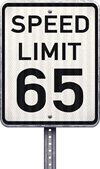Environmental Speed Limits
Latest Updates
The Regional Transportation Council (RTC) approved the conversion of Environmental Speed Limits (ESLs) to Transportation Control Measures on August 14, 2014. North Central Texas Council of Governments (NCTCOG) worked closely with the Texas Department of Transportation (TxDOT) Dallas and Fort Worth Districts to develop a consistent plan to adjust speed limits on roadways designated as ESLs in 2001.
As a part of this process, the TxDOT districts conducted speed studies to determine the appropriate speed adjustments needed for each ESL roadway segment. The Texas Transportation Commission (The Commission) officially adopted the proposed speed changes in January 2015. The speed studies resulted in a reversal of the ESL to the original speed limit in 2001 for some roadway segments; however, in other instances the speeds were increased more than five miles per hour (mph), and in others the speeds were reduced. As a result of on-going construction, there are some ESLs that have not been adjusted, pending completion of the construction and speed studies. As of July 2015, all roadway segments with completed speed studies, in both the Dallas and Fort-Worth TxDOT Districts, have been updated to reflect the adjusted speeds.
Historical Information
On April 28, 2000, the Texas Natural Resource Conservation Commission (TNRCC), the State of Texas' environmental agency, submitted the Dallas-Fort Worth (DFW) Attainment Demonstration State Implementation Plan (SIP) to the U.S. Environmental Protection Agency (EPA). The SIP contains several emission reduction control strategies to improve air quality in the region to reach attainment by November 15, 2007. One of those control strategies is the Speed Limit Reduction Measure, adopted by the RTC on December 14, 2000.
The Speed Limit Reduction Measure states, "Beginning September 1, 2001, speed limits on roadways with a current maximum speed limit of 70 mph will be reduced to 65 mph, while speed limits on roadways with a current maximum speed limit of 65 mph will be reduced to 60 mph." The Speed Limit Reduction Measure has been implemented in the Counties of Collin, Dallas, Denton, Ellis, Johnson, Kaufman, Parker, Rockwall and Tarrant.
The Texas Commission on Environmental Quality (TCEQ), formerly known as the TNRCC, is responsible for identifying roadway locations effected by this SIP rule. On behalf of the TCEQ, NCTCOG, serving as the Metropolitan Planning Organization for the DFW Metropolitan Area, inventoried roadways with current speed limits of 65 mph and 70 mph in the North Central Texas region. NCTCOG coordinated with TxDOT, the North Texas Tollway Authority (NTTA), and local governments to achieve an accurate listing of affected roadways and to begin the process of implementing the speed reductions.
Acknowledging the need for speed limit reductions in the region to improve air quality, the Regional Transportation Council approved the transmittal of the map and listing of affected roadways to the TCEQ on December 14, 2000. TCEQ, serving as the regulatory agency, submitted the request for the speed limit changes to TxDOT-Austin and to NTTA. The Commission has the authority to change speed limits for the State highway system. After evaluating the request from the TCEQ, the Commission made final determination for approval of the speed limit reduction request in January 2001. The Commission then sent approval back to TxDOT-Dallas and TxDOT-Fort Worth Districts for implementation. The NTTA Board of Directors has the authority to change speed limits on toll roads in North Central Texas. Hence, the NTTA Board of Directors made final determination for approval of the speed limit reduction request for all toll roads in North Central Texas.
In 2003, the 78th Texas Legislature passed and the Governor signed into law House Bill 1365, relating to the Texas Emissions Reduction Plan and discontinuing ESLs. In Section 545.353(j) of the Texas Transportation Code, the existing ESLs are retained; however, the authority of the Texas Transportation Commission to approve ESLs in the State is removed. The Code goes on to explain, the existing ESLs will remain in effect until the TCEQ advises TxDOT differently, and a speed study is performed.
As a result of the 2003 Legislative change and changes to emissions modeling, NCTCOG staff began the process to increase the speed limits on NTTA facilities. In order to change the speed limits and avoid violating anti-backsliding policy, NCTCOG staff initiated the process to convert ESLs from a stand-alone control strategy in the One-Hour and Eight-Hour SIP to a Transportation Control Measure (TCM). Converting ESLs to a TCM will allow NCTCOG to initiate a TCM Substitution Process to ensure equal emissions benefits are gained from the TCM substituted in place of the ESL.
In 2010, NCTCOG submitted the ESL to TCM SIP to the TCEQ, who subsequently adopted the SIP in December 2010 and sent to EPA for approval. Following this SIP revision, the 82nd Texas Legislature passed, and the Governor signed into law House Bill 1353, relating to speed limits. In Section 545.352 of the Texas Transportation Code, the Texas Transportation Commission is authorized to increase speed limits up to 75 mph on State highways and U.S. Highways outside an urban district, establish the same speed limit for daytime and nighttime, and remove different, lesser speed limits for heavy-duty vehicles. As a result of this new legislation, EPA's Motor Vehicle Emissions Simulator (MOVES) model showing no increase in emissions at higher speeds, and EPA's direct final rule published in the Federal Register on January 9, 2014, the Dallas and Fort Worth TxDOT Districts began the process of reversing the 2001 ESLs.
Regional Transportation Council Presentations
August 14, 2014
July 10, 2014
March 13, 2014
For additional information about the Environmental Speed Limits in the Dallas-Fort Worth area, please contact Jenny Narvaez.
